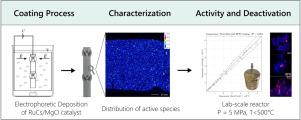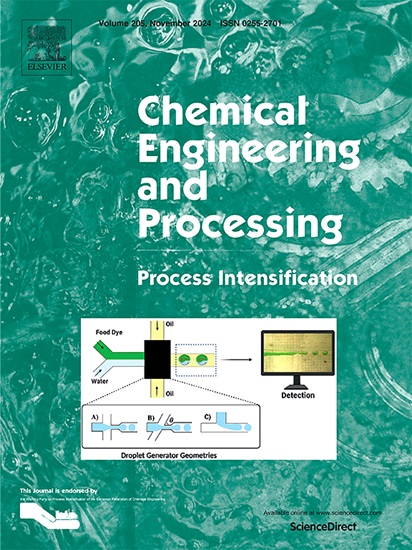通过电泳沉积在添加剂制造的支撑结构上涂覆 RuCs/MgO 催化剂用于合成氨的性能
IF 3.8
3区 工程技术
Q3 ENERGY & FUELS
Chemical Engineering and Processing - Process Intensification
Pub Date : 2024-10-11
DOI:10.1016/j.cep.2024.110019
引用次数: 0
摘要
这项研究探讨了在所谓的流体导向元件(FGE)上电泳沉积催化涂层,并在氨合成反应器中使用钌基催化剂。FGE 是一种添加剂制造的金属管道插入件,与空管道相比,它通过分割流体流并交替引导部分流向管壁来提高传热效果。因此,它们可以提高对温度敏感的结构催化系统的性能。为了证明工艺强化的程度,我们开发了氨合成参考催化剂沉积所需的步骤。此外,还对催化活性化合物的分布进行了描述。在压力高达 5 兆帕的塞流反应器中对催化活性进行了评估,并与同批次的固定床进行了比较。参考催化剂的预期活性是通过动力学速率表达式计算得出的。涂层工艺不会影响催化活性,但会出现稳定的失活现象,而且对原料气体杂质的敏感性很高。对失活的可能机制进行了研究和讨论。本文章由计算机程序翻译,如有差异,请以英文原文为准。

Performance of a RuCs/MgO catalyst coated on additive manufactured support structures via electrophoretic deposition for ammonia synthesis
This work investigates the electrophoretic deposition of a catalytic coating on so-called fluid guiding elements (FGE) with a ruthenium-based catalyst for use in ammonia synthesis reactors. FGE are additive manufactured metallic pipe inserts that have shown to enhance the heat transfer compared to empty pipes by dividing the fluid flow and alternately guiding the partial flows to the wall. Consequently, they could improve the performance of temperature sensitive structured catalytic systems. To be able to demonstrate the degree of process intensification, the required steps to enable the deposition of a reference catalyst for ammonia synthesis are developed. Further, the distribution of catalytically active compounds is characterized. The catalytic activity is assessed in a plug flow reactor under pressures up to 5 MPa and compared against a fixed bed from the same batch. The expected activity from the reference catalyst is calculated by a kinetic rate expression. The coating process does not affect catalytic activity, but a steady deactivation and high sensitivity to feed gas impurities are observed. Possible mechanisms for the deactivation are examined and discussed.
求助全文
通过发布文献求助,成功后即可免费获取论文全文。
去求助
来源期刊
CiteScore
7.80
自引率
9.30%
发文量
408
审稿时长
49 days
期刊介绍:
Chemical Engineering and Processing: Process Intensification is intended for practicing researchers in industry and academia, working in the field of Process Engineering and related to the subject of Process Intensification.Articles published in the Journal demonstrate how novel discoveries, developments and theories in the field of Process Engineering and in particular Process Intensification may be used for analysis and design of innovative equipment and processing methods with substantially improved sustainability, efficiency and environmental performance.

 求助内容:
求助内容: 应助结果提醒方式:
应助结果提醒方式:


